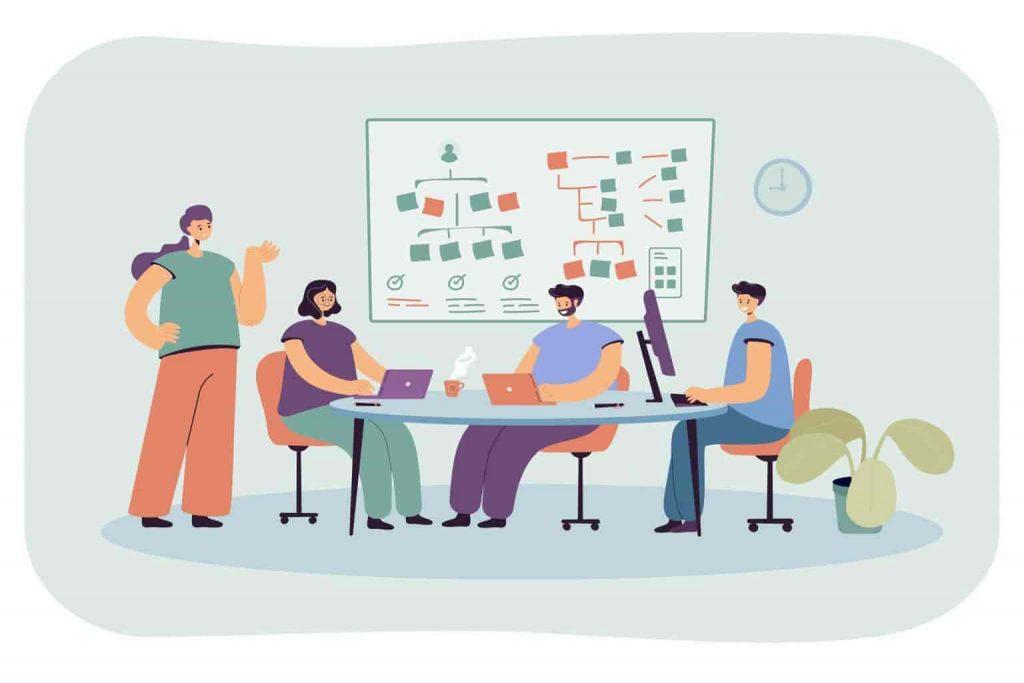Joint Application Development (JAD) is a methodology that has direct involvement of the client and end-user while designing and developing computer-based applications. The motive is to understand the ideal solution to be achieved. As per the business needs, the requirements are collected alongside developing the new information systems.
The JAD process enhances user participation, accelerating development, and hence improving the quality of specifications. This includes approaches for refining the quality of specification through successive collaborative workshops of JAD sessions.
As the client is involved throughout the development process, it drives faster development and greater client satisfaction.
JAD sessions can be plainly put as:
- Simplification: The process of understanding the type of work and requirements of the project.
- Identification: Finding the issues concerned with the project and the participants involved in it.
- Quantification: To accumulate the information and requirements needed to process the whole project.
- Clarification: To clarify and crystallize all the conditions agreed upon in the session.
- Unification: The challenge while doing a sizable project is to create connections from one phase of development to another.
- Satisfaction: Shared participation of users brings in a share in the outcome and towards the system’s success resulting in overall satisfaction.
The participants in a Joint Application Development:
- Executive Sponsor: A few people in charge of this process from the customer’s organization, such as the Project Leader, the CIO, the CEO, and the CISO, have the authority to make decisions about the project.
Responsibilities are:
- Authorized and responsible for the functioning of the system.
- Decision-making in resolving business policy conflicts.
- Setting the vision of the project.
- Ensuring the commitment from the right business user experts.
- Facilitator: JAD activities are created, managed, and executed according to this individual’s plans; minimal disagreements are minimized, end-user participation is encouraged, and a balance and unbiased approach is maintained.
Responsibilities are:
- Schedule and Organize JAD activities.
- Resolving disputes.
- Moderate and guide JAD activities.
- Leading the decision-making process by summarizing the discussions.
- Zero vested interest.
- IT Representatives: They are duty bound to provide technical advice and assist the team in developing technical models and building the prototype of the end result. They are usually the key developers within the system.
Responsibilities are:
- Understanding the customer’s visualizations and ideas.
- Help customers turn these ideas into models as per the business requirements.
- Developing and understanding the end-user business goals.
- Assist in the management of production/operations, data administration, business analysis, programming, prototyping, and product development.
- Render-end solutions that are affordable in nature etc with the advantage of available technology.
- End-User: JAD is mainly focused on the end-user. They offer proper business knowledge and strategy, illustrate all key user groups who are affected by development, and represent multiple levels within an organization.
Responsibilities are:
- Provide business expertise.
- Represent the tactical, strategic, or operational course of the business.
- Representation of the major user groups and the affected factions by the project.
- Multiple-level representation of the organization.
- Scribe: The documentation of the JAD process and JAD sessions is precisely and effectively done by the scribe. They generally act as a reference source for future reviews of past sessions.
- Observer: The job of the observer is to observe each JAD session and see if the decisions taken during the session or workshop meet the end-user needs. Then interact with them only after the session is over.
The procedure of conducting beneficial JAD Sessions:
- There should be well-defined goals and agendas while conducting JAD sessions.
- Key persons shall be present from the business and technical departments.
- Questionnaires and items of discussion are important for driving the meeting.
- Important items and results must be recorded and assigned to the responsible ones.
- JAD sessions are conducted to trigger creative thinking that leads to joint discussion for which expertise is required from various departments.
- The decision-making should be a team effort. So that no one is left out and everyone can work unanimously for the same result.
Advantages of Joint Application Development:
- Helps in creating a design from the customer’s perspective.
- Every risk element gets eliminated by the teamwork between the company and the client.
- Faster progression due to the close interactions.
- JAD sessions help accelerate design that helps in enhancing the quality.
- JAD cheers the team to push each other which leads them to work faster and deliver on time.
- JAD sessions allow the team to keep motivated and encourage others to work faster and timely delivery.
Challenges faced in Joint Application Development:
- The size of the project determines the time required to spend for the JAD. And a significant amount of time may be spent as well for the same.
- There may be times when the opinions from within the team differ, making it difficult to align goals and maintain the focus.
Conclusion:
Joint Application Development (JAD) may or may not be the answer an organization needs. But it provides an inclusive and flowing environment than others alike. One of the aims of JAD is to bring the users and MIS together in a structured workshop setting for extracting consensus-based system requirements. It has been found that JAD minimizes the development time, errors, and cost.
We Provide Best Services. Need Help?
Send Us Message
Just send us your questions or concerns by starting a new case and we will give you the help you need.



 Schedule An Appointment
Schedule An Appointment